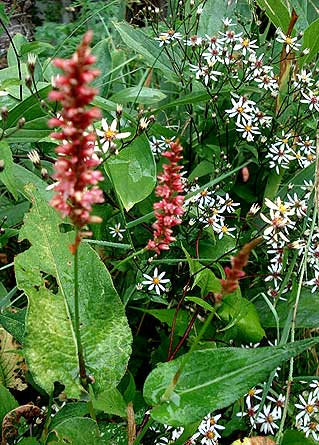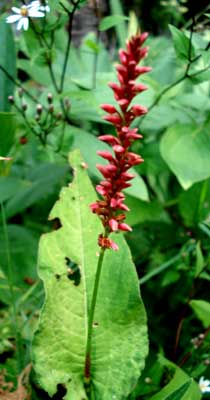
'Orangefield' Knotweed
aka, Mountain Fleeceflower
or, Bistort
"We may track the mighty sun above,
Even by the shadow of a slender flower."
-Henry Timrod
(1828-1867)
A chap named Chris Ghyselen in Belgium set upon a long journey of breeding new varieties of his personal favorite but often overlooked perennial wildflower, Persecaria amplexicaulis, the while promoting the garden-worthiness of a plant that had the misfortune of having 'weed' right there in its common name, knotweed.(1828-1867)
 The first gambit was to call it by its genus name Persecaria, or its alternative common name Fleeceflower. Formerly called Bistorta amplexicaulis, it is still occasionally called by the common name Bistort.
The first gambit was to call it by its genus name Persecaria, or its alternative common name Fleeceflower. Formerly called Bistorta amplexicaulis, it is still occasionally called by the common name Bistort.The next & vastly more important gambit was to develop cultivars with bigger blooms & greater color variety. This has certainly won many fans for this species, including myself, though it still seems to be a relatively rare offering in nurseries.
P. amplexicaulis 'Orangefield' is one of Ghyselen's several knotweed varieties, with a rich coral or orange-pink bloom that can grow to about three feet or forty inches high, holding aloft its upright foxtail of a bloom. It will grow down to zone four, likes full sun, & regular watering in well-draining soil.
Mountain Fleeceflower, originating in the Himalayas, can be an invasive weed in its strictly wild form. But the cultivars are hardy without being aggressive. They want a lot of sun but do not like hot roots & fade away in droughty conditions, so it's nice to have them mixed with some small groundcover.
Ours has to compete with a floppy woodland aster that spreads its extremely dense roots quite rapidly, & this has kept our one Fleeceflower from taking off swiftly, but it has held its own & flowered nicely.
In our garden it begins to bloom in late July or early August, with each bloom very long-lasting. With one shearing or deadheading, it'll rebloom throughout October or first frost. The four inch tall narrow spike of a flower is a butterfly attractant, excellent as cut flowers for bouquets. The leaves are loosely arranged spearheads, resistent to deer.